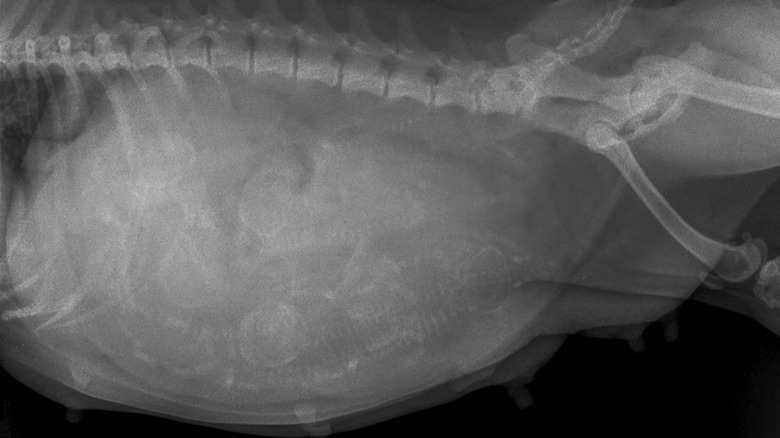The Stages Of Pregnancy In Pit Bulls
Pregnancy is an exciting and energy-intense time in your dog's life. The arrival of puppies can be a wonderful learning experience for everyone involved. However, It's best to know the various stages and indicators of pregnancy, signs of labor, and what to do if you encounter a problem before your pit bull ventures into motherhood.
Pit bulls go through the same stages of pregnancy as other dog breeds. However, there are some unique considerations you should keep in mind. While pit bulls aren't a breed at higher risk of dystocia, or difficult birth, they can still have issues. Your dog's pelvis size may also present a problem, especially if her pelvis is narrow and the puppies are larger.
A canine pregnancy consists of several stages: pre-pregnancy, when your dog is in heat; the first half of pregnancy; the second half of pregnancy; and labor and whelping, or the act of giving birth. Gestation, or the full pregnancy, can take from 57 to 72 days, but typically spans around 63 days. However, this can vary depending on the age of the dog and if she's had any previous pregnancies.
Before your pit bull becomes pregnant
Before you decide to breed your pit bull, you should make sure she is healthy and in good shape. A breeding soundness exam can be done by your veterinarian or a theriogenologist — a veterinarian who specializes in reproduction. The breeding soundness exam can help rule out issues, like inheritable diseases. It's also important that both parents are examined to ensure healthy puppies.
The peak time for your pit bull to become pregnant is during her heat cycle. A dog's heat cycle typically lasts 18 to 21 days. You'll also see signs of your dog being in heat, including bloody vaginal discharge, swelling of the vulva, and increased reception of males. Intact male dogs will also show more interest in females while they're in their heat cycle. During this period, your dogs will breed several times. If you're using artificial insemination, your veterinarian can help you determine the best time for treatment.
The first half of a pit bull's pregnancy
Dog pregnancies tend to either be separated into trimesters of about 20 days each or broken down into the first and second halves of pregnancy. During the first half of pregnancy, you'll start to see early symptoms, typically within a few weeks. Signs that your dog may be in early pregnancy include weight gain, abdominal swelling, and appetite changes. Your dog may also become suddenly clingy, following you around from room to room.
The first half of pregnancy is also when your vet can confirm that your pit bull is pregnant. An abdominal ultrasound is the most common way for your vet to diagnose pregnancy. However, palpation, the act of feeling with the hands during examination, and hormone tests can also be used to confirm it. You can try to palpate your pregnant dog at home to see if you can feel any changes; however, it's always best to confirm your dog is pregnant with your veterinarian.
While some vaginal discharge is normal during early pregnancy, excessive discharge can be a sign of something else wrong. Pyometra, or a uterus infection, can mimic the early signs of pregnancy in dogs. However, you may see other worrisome symptoms such as fever, lethargy, or cloudy or milky discharge. It's best to seek veterinary care right away, as it can quickly become an emergency situation.
The second half of a pit bull's pregnancy
The second half of your pit bull's pregnancy is when you'll notice the most changes. This is the time of rapid puppy growth and when you'll see your dog gain a bit more weight. During this time, it's a good idea to begin feeding your dog a puppy diet. Puppy formulations of dog food are higher in many nutrients needed to help developing puppies in the womb, and also provide extra energy for producing milk during nursing.
As your dog gets closer to her due date, your veterinarian can confirm the size and number of puppies through an X-ray. The X-ray will pick up the puppy's skulls and vertebrae and can help you estimate the number of puppies to expect. This is beneficial for when your dog goes into labor, as you'll be able to determine when she's had all of her puppies.
Your pit bull will also have some changes as she nears labor. Nesting behavior and swollen nipples are the most common changes that occur prior to labor. This is the perfect time to make sure you have a whelping kit for dogs set up and ready to go, as well as any needed materials, including the phone number of your veterinarian or emergency clinic.
Labor and whelping
When your pit bull is ready to go into labor, she may become restless and pace or lose her appetite. A few hours prior to labor, you may begin to see contractions along the abdomen, as well as vaginal discharge. In addition, you can take your dog's temperature to check for early labor. Body temperature will usually drop within 24 hours of the first puppy being born.
During labor, you'll want to watch for signs of dystocia, or difficult birth. It can be a sign of something wrong if your dog is in labor for more than 24 hours without any puppies. Other signs include taking more than a few hours passing between the arrival of puppies and extreme exhaustion during labor. If you notice any of these symptoms, or notice a puppy stuck in the birth canal, it's best to seek emergency veterinary care immediately.
After your dog gives birth, she'll clean up the puppies and, if they haven't been removed from the whelping box, eat their placentas — each dog has its own — to help keep the box clean. It's important to monitor for any signs of distress after giving birth and to check the puppies for any problems. If you do spot any issues, a trip to the vet is best.




